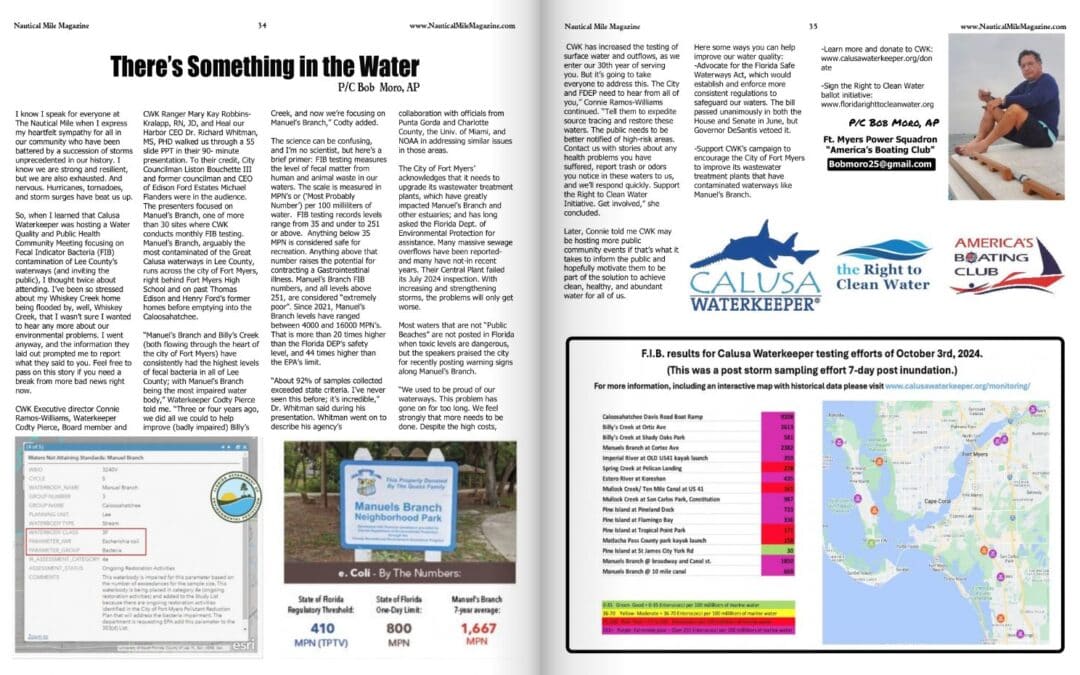Originally published by Bob Moro in the Nautical Mile on November 18, 2024
I know I speak for everyone at The Nautical Mile when I express my heartfelt sympathy for all in our community who have been battered by a succession of storms unprecedented in our history. I know we are strong and resilient, but we are also exhausted and nervous. Hurricanes, tornadoes, and storm surges have beat us up.
So, when I learned that Calusa Waterkeeper was hosting a Water Quality and Public Health Community Meeting focusing on Fecal Indicator Bacteria (FIB) contamination of Lee County’s waterways (and inviting the public), I thought twice about attending. I’ve been so stressed about my Whiskey Creek home being flooded by, well, Whiskey Creek, that I wasn’t sure I wanted to hear any more about our environmental problems. I went anyway, and the information they laid out prompted me to report what they said to you. Feel free to pass on this story if you need a break from more bad news right now.
CWK Executive director Connie Ramos-Williams, Waterkeeper Codty Pierce, Board member and There’s Something in the Water P/C Bob Moro, AP, CWK Ranger Mary Kay Robbins-Kralapp, RN, JD, and Heal our Harbor CEO Dr. Richard Whitman, MS, PHD walked us through a 55-slide PPT in their 90-minute presentation. To their credit, City Councilman Liston Bouchette III and former councilman and CEO of Edison Ford Estates Michael Flanders were in the audience.
The presenters focused on Manuel’s Branch, one of more than 30 sites where CWK conducts monthly FIB testing. Manuel’s Branch, arguably the most contaminated of the Great Calusa waterways in Lee County, runs across the city of Fort Myers, right behind Fort Myers High School and on past Thomas Edison and Henry Ford’s former homes before emptying into the Caloosahatchee.
“Manuel’s Branch and Billy’s Creek (both flowing through the heart of the city of Fort Myers) have consistently had the highest levels of fecal bacteria in all of Lee County; with Manuel’s Branch being the most impaired water body,” Waterkeeper Codty Pierce told me. “Three or four years ago, we did all we could to help improve (badly impaired) Billy’s Creek, and now we’re focusing on Manuel’s Branch,” Codty added.
The science can be confusing, and I’m no scientist, but here’s a brief primer: FIB testing measures the level of fecal matter from human and animal waste in our waters. The scale is measured in MPN’s or (‘Most Probably Number’) per 100 milliliters of water. FIB testing records levels range from 35 and under to 251 or above. Anything below 35 MPN is considered safe for recreation. Anything above that number raises the potential for contracting a gastrointestinal illness. Manuel’s Branch FIB numbers, and all levels above 251, are considered “extremely poor.” Since 2021, Manuel’s Branch levels have ranged between 4000 and 16000 MPN’s. That is more than 20 times higher than the Florida DEP’s safety level, and 44 times higher than the EPA’s limit.
“About 92% of samples collected exceeded state criteria. I’ve never seen this before; it’s incredible,” Dr. Whitman said during his presentation. Whitman went on to describe his agency’s collaboration with officials from Punta Gorda and Charlotte County, the Univ. of Miami, and NOAA in addressing similar issues in those areas.
The City of Fort Myers acknowledges that it needs to upgrade its wastewater treatment plants, which have greatly impacted Manuel’s Branch and other estuaries; and has long asked the Florida Dept. of Environmental Protection for assistance. Many massive sewage overflows have been reported—and many have not—in recent years. Their Central Plant failed its July 2024 inspection. With increasing and strengthening storms, the problems will only get worse.
Most waters that are not “Public Beaches” are not posted in Florida when toxic levels are dangerous, but the speakers praised the city for recently posting warning signs along Manuel’s Branch.
“We used to be proud of our waterways. This problem has gone on for too long. We feel strongly that more needs to be done. Despite the high costs, CWK has increased the testing of surface water and outflows, as we enter our 30th year of serving you. But it’s going to take everyone to address this. The City and FDEP need to hear from all of you,” Connie Ramos-Williams continued. “Tell them to expedite source tracing and restore these waters. The public needs to be better notified of high-risk areas. Contact us with stories about any health problems you have suffered, report trash or odors you notice in these waters to us, and we’ll respond quickly. Support the Right to Clean Water Initiative. Get involved,” she concluded.
Later, Connie told me CWK may be hosting more public community events if that’s what it takes to inform the public and hopefully motivate them to be part of the solution to achieve clean, healthy, and abundant water for all of us.
Here are some ways you can help improve our water quality:
- Advocate for the Florida Safe Waterways Act, which would establish and enforce more consistent regulations to safeguard our waters. The bill passed unanimously in both the House and Senate in June, but Governor DeSantis vetoed it.
- Support CWK’s campaign to encourage the City of Fort Myers to improve its wastewater treatment plants that have contaminated waterways like Manuel’s Branch.
- Learn more and donate to CWK: www.calusawaterkeeper.org/donate
- Sign the Right to Clean Water ballot initiative: www.floridarighttocleanwater.org
Ft. Myers Power Squadron “America’s Boating Club”
P/C Bob Moro, AP

























